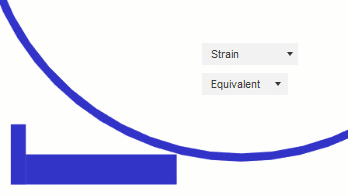Tutorial: Sheet metal pass through a roller
This tutorial uses a Dynamic Event Simulation analysis to model the rolling of a steel slab, to simulate the manufacture of steel plate. This is a process that is repeated multiple times in the manufacturing of steel plate where a large billet of steel is passed through a series of rollers to achieve the final plate thickness. Here we model a single pass through a roller to produce a 25% reduction in the thickness of the plate.
The roller has a radius of 175 mm and is spinning at a fixed angular velocity of 314.159 rad/s, which corresponds to 3000 RPMs (revolutions per minute). While this is much faster than a real-world rolling machine would operate, at this speed the analysis time is very short and the results are quite comparable to real-world speeds of ~60 RPMs.
The steel slab is 20 mm thick initially and 100 mm long, and is pushed into the roller by a rigid block. Friction between the roller and the steel slab then draws the plate through the rolling process. For the purposes of this tutorial, the out-of-plane thickness of the model is 20 mm.
In this tutorial you
- Create a dynamic Event Simulation study and define its parameters
- Define rigid bodies and change the model materials
- Apply fixed and prescribed (time dependent) constraints
- Define rotational and translational initial conditions
- Optimize the contact conditions
- Run the analysis and review the results
 |
 |
| Sheet metal rolling model design | Animation showing sheet metal strains as it is flattened by 25%. |
Prerequisites
- To complete this tutorial, your Autodesk account needs sufficient tokens to run the analysis, or an active subscription to the Fusion Simulation Extension.
